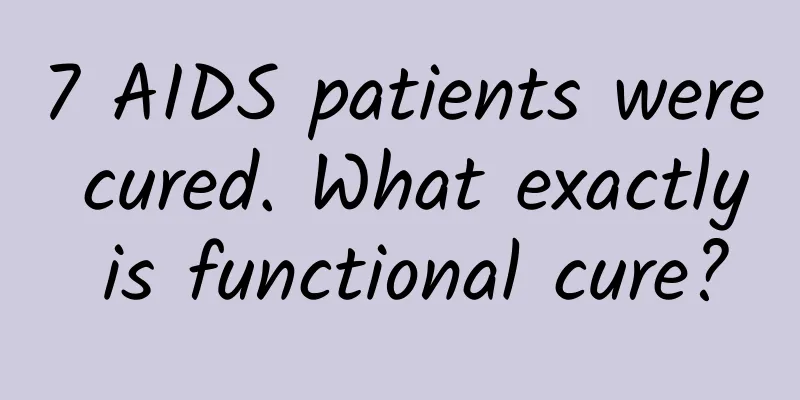7 AIDS patients were cured. What exactly is functional cure?

|
Tuchong Creative AIDS is the full name of acquired immunodeficiency syndrome (AIDS), which is caused by infection with the human immunodeficiency virus (HIV). HIV mainly damages the human immune system, destroys T lymphocytes in the body, causing severe weakening of the human immune function, thereby causing various infections and tumors, threatening life safety. AIDS spreads rapidly and has a high mortality rate. It remains one of the world's most serious public health challenges. According to data from the United Nations AIDS Program in 2023, there are 39 million people infected with HIV worldwide, of which 29.8 million are receiving antiretroviral treatment. According to data from the Chinese Center for Disease Control and Prevention, as of the end of 2022, there were 1.223 million reported cases of HIV infection in my country, and a total of 418,000 deaths were reported. Behind these figures are countless families living in fear under the shadow of the disease. On July 22 this year, the 25th World AIDS Conference was held in Munich, Germany. One of the biggest highlights of the conference was the seventh case of AIDS cure after allogeneic hematopoietic stem cell transplantation (HSCT) in the world, known as the "next Berlin patient." This is exciting good news, but does it mean that AIDS has been conquered? To answer this question, we must first understand the pathogenesis of AIDS. HIV mainly invades the human body's CD4+ helper T lymphocytes. Its invasion process first binds to the CD4 receptor on the surface of the target cell, and then binds to the CCR5 or CXCR4 complex receptor. This process can change the configuration of HIV membrane protein, allowing the virus to fuse with the cell and enter the cell. HIV belongs to the genus Lentivirus of the Retroviridae family. It is an enveloped RNA virus. After entering the human cell, the viral RNA synthesizes a proviral DNA copy of the RNA genome under the action of reverse transcriptase. The provirus migrates into the host cell nucleus and integrates into the host cell genes around the nucleus. There are two destinations after that. One is to continuously replicate and assemble to form new HIV particles, the host cell lyses and dies, and the released virus particles continue to infect other cells; the other is that the viral DNA is passed to the daughter cells with the division of the host cell and enters the latent period. Once stimulated and activated, it can replicate in large quantities, causing the cell to lyse and die. Traditional AIDS treatment is antiretroviral therapy (ART). The drug target is reverse transcriptase, which can only inhibit HIV reverse transcription replication, but cannot eliminate proviral DNA hidden inside cells. ART treatment is like a pair of scissors, trimming the massively multiplying viral "weeds" to prevent them from spreading outward. But it only treats the symptoms and not the root cause. The roots of these "weeds" - viral reservoirs, can always lurk in hidden corners. Once the pruning stops, the "weeds" will grow rapidly and reoccupy the territory. Therefore, ART treatment requires long-term and uninterrupted medication, and is still far from a true "cure." There are two types of AIDS cures: one is "eradication cure", which means completely eliminating the virus; the other is "functional cure", which means that the viral load in the patient's body is so low that it cannot be detected without ART treatment, and there are no AIDS-related symptoms or HIV transmission risks. With the current medical level, it is basically impossible to achieve eradication cure, but functional cure is already in sight. The "next Berlin patient" mentioned above is a functional cure. He was followed up for 10 years after allogeneic hematopoietic stem cell transplantation, and ART treatment had been stopped for 6 years. Among the 6 previously cured patients, the hematopoietic stem cells received by 5 patients contained homozygous mutations in the CCR5 gene. Studies have found that people with CCR5 gene mutations are inherently resistant to HIV because their T cells cannot synthesize normal CCR5 receptors, so HIV cannot adsorb and invade. The immune system of patients who receive hematopoietic stem cell transplantation is reshaped, and the original T cells are replaced by T cells carrying CCR5 gene defects, thus achieving cure. However, this therapy has great limitations and carries risks such as severe infection and rejection. It is currently only used for malignant tumors. The "next Berlin patient" is a patient with AIDS and acute leukemia. In addition, it is difficult to find a donor with a matching bone marrow type, and there are very few who carry the CCR5 gene mutation. The scarcity of donors is an important factor limiting the large-scale application of stem cell transplantation in AIDS patients. It is worth noting that, unlike previous cured cases, the donor of the "next Berlin patient" did not carry a homozygous mutation in the CCR5 gene, but a heterozygous mutation (that is, one normal gene and one defective gene). The successful cure of the "next Berlin patient" has expanded the range of choices for transplant recipients for AIDS patients. In addition, the genetically modified "therapeutic T cell vaccine", or CAR-T therapy, also has great potential in curing AIDS. In May of this year, Professor Xu Jianqing's team at the Shanghai Public Health Clinical Center of Fudan University developed a cell therapy called "M10 CAR-T" and published it in the top journal "Cell Discovery". M10 cells have triple biological functions. They can kill HIV-infected host cells through cytotoxicity. The broadly neutralizing antibodies they carry can also neutralize free viruses outside the cells. At the same time, M10 cells can use the homing effect to enter the viral reservoir and attack hidden viruses. In the published Phase I clinical trial, 18 AIDS patients received this new therapy, and the average viral load in their bodies was reduced by 67.1%. CAR-T therapy has great potential, but it also faces many challenges. The large-scale expansion of CAR-T cells in a short period of time may lead to cytokine release syndrome, and patients may experience fever, hypotension, and even organ failure. In addition, CAR-T cells need to be tailored to each patient, so they are expensive. In my country, the price is more than one million yuan, and many patients cannot afford it. CAR-T treatment of AIDS is still in the clinical trial stage, and its long-term safety and effectiveness remain to be seen. Humanity has not yet conquered AIDS, but we believe that one day, this goal will be achieved. We look forward to that day. This article is a work supported by the Science Popularization China Creation Cultivation Program Author: Li Jinghui Reviewer: Shi Feng, deputy chief physician, Yueyang Tower Center for Disease Control and Prevention, Yueyang City Produced by: China Association for Science and Technology Department of Science Popularization Producer: China Science and Technology Press Co., Ltd., Beijing Zhongke Xinghe Culture Media Co., Ltd. |
Recommend
What to do if you can't defecate during pregnancy
We all know that many women will suffer from cons...
[Medical Q&A] Does a test report showing abnormal myocardial enzyme spectrum mean myocardial infarction?
Planner: Chinese Medical Association Reviewer: Ni...
Yellow throat, hairy tripe, chicken gizzards...you never know what you are eating!
Who would refuse a hot pot invitation? From the i...
What to eat during menstruation to replenish qi and blood
Women with deficiency of both Qi and blood often ...
38 weeks of pregnancy with lower abdominal pain
For pregnant women, the late pregnancy is a very ...
What is the problem of endometrium not growing?
A woman's endometrium is very magical. It cha...
5-minute breast enhancement tips
The new women in the 21st century are particularl...
What is the reason for slow follicle growth?
Under normal circumstances, when a woman's fo...
There are so many benefits of drinking tea, but doctors in West China say: It is better not to drink it
If I have to choose a "ceiling for human tea...
A woman with a mole on the palm of her left hand
In the complete collection of mole illustrations,...
What kind of scallops are of good quality? What are the ways to eat scallops?
In our daily life, if you don't know what to ...
How to recover from hemorrhoids after vaginal delivery
Hemorrhoids are a very painful disease. Hemorrhoi...
What are the methods to delay menstruation?
Women have their periods every month due to their...
Can I smell 84 disinfectant when I am pregnant?
Disinfectant is a necessary item in many househol...
Hahahaha! Why does your expression look so ugly when you're asleep?
Everyone must have had ugly photos of themselves ...









